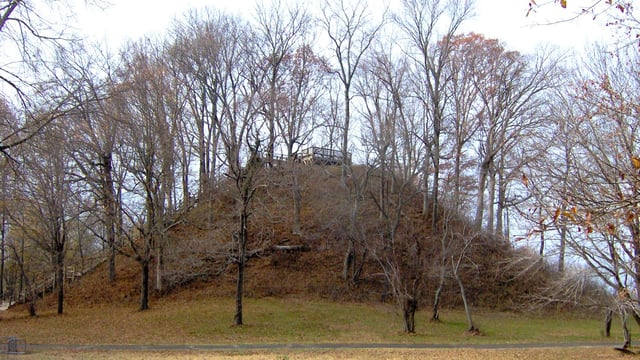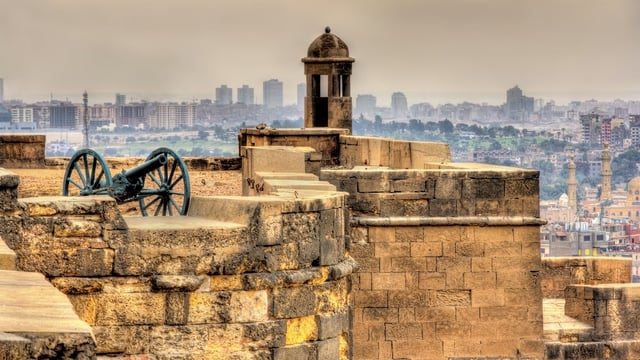About 11 miles south of Jackson, Tennessee, outside the small town of Pinson, lies one of the largest mound sites in the Eastern United States. The site is a ceremonial earthwork complex that includes 17 mounds, covers an area of approximately 400 acres, and contains the second-highest surviving mound in the United States.
- Nicholas Vamvakias
- Last Checked and/or Updated 8 January 2023
- No Comments
- Featured Image © Brian Stansberry / Wikipmedia
- Tennessee
As you approach the visitors centre, you will be struck by a couple of things. First, the centre itself is built to look like a large platform mound. Just a little ways behind it though, stands what is thought to be the centre of the complex, a 72-foot-tall earthwork mound, known as Sauls’ Mound.
As I approached it, the size of the construction and its age was almost incomprehensible to me. It would require a line of bumper-to-bumper, average-sized dump trucks 42 km (26 miles) long to transport the roughly 60,500 cubic meters of dirt that composes the mound. And all of it was excavated, transported, deposited, shaped, and aligned entirely by hand. And it had persisted, more or less as it was, for nearly 2,000years.
My awe was only reinforced when I climbed to the observation platform built on top of the mound. As the trees atop the mound had recently been cleared, it offered an especially commanding view of the park and surrounding area. Even the town of Jackson was just about visible 11 miles away! Sauls’ Mound is a marvel of engineering and organization, plain and simple. But it is one that seems to remain relatively unknown. When I visited the site, it was a fairly quiet experience, only running into a handful of people.
It is hard to realize that in the State of Tennessee ruins of a great ancient walled city with outer defences measuring fully six miles in length, with elaborate outer and inner citadels, with 35 mounds of various sizes should have remained almost unknown beyond the bare fact that near the little railroad station of Pinson, in Madison County, there were some mounds and enclosures.
Pinson Mounds History
The Pinson Mound site was constructed sometime in the Middle Woodland Period, around 0 – 500 CE. This period in the Eastern United States was marked by an increase in monument building and agricultural development, but broadly speaking, populations maintained a fairly dispersed and nomadic lifestyle. Some archaeologists refer to their strategy as hunter-gatherer-gardener, as they grew domesticated, low-maintenance crops, like squash, sunflowers, and the newly introduced maize. This suite of crops is known as the Eastern Agricultural Complex.
The complex is located on the South Fork of the Forked Deer River, on a relatively flat location that overlooks the nearby floodplain. There is evidence to suggest that the river was navigable at least as far as Jackson, TN before the deforestation of West Tennessee in the 1800s. It is associated with two other mound sites along this stretch of the South Fork Forked Deer River, the Johnston site, and the Elijah Bray group. Like Pinson, they were built during the Middle Woodland Period, and their presence alongside Pinson suggests that this stretch of the river held significance to the people who built them.
What is the significance of the Pinson Mounds?
What is interesting to note is that the Pinson Mounds site actually has more in common with those constructed by the contemporary, but physically distant, Ohio Hopewell culture group than the later, but local, Mississippian culture group. As opposed to Mississippian mound sites, like Cahokia or Etowah, these were not fortified cities and were not permanently inhabited. Instead, these sites are thought instead theorized to have a more ceremonial and religious role, serving as the sites for periodic rituals, ceremonies, or exchanges.
Pinson was likely constructed overtime, with mounds and embankments added to it as needed by its builders. While we can’t know exactly what went on at the site, archaeology allows us to propose informed ideas. Some elements of the site suggest a religious purpose: it features burial mounds, the four corners of Sauls’ Mound are oriented to the four cardinal directions, and Mound 29 is aligned with Sauls’ Mound to the equinox sunrise. Additionally, the ceramics found at the site, especially at the Duck’s Nest, come from a wide variety of styles, originating as far away as southern Georgia and southern Appalachia. This corroborates the standing theory that the earthworks were constructed by pilgrims to the site who came from different areas but were united in a cosmological or religious sense.After 350 CE, earthen work construction at Pinson stopped, and ceramic assemblages suggest that the site was no longer a pilgrimage destination. There are no known habitation sites within the mound complex until around 1000 CE when a few families of the Mississippian culture group built their homes in an area previously used for short-term occupation during the original activity at Pinson.
Who Built the Pinson Mounds?

What is there to See and Do in the Pinson Mounds State Archaeological Park
The Park
Along the paths, there are several interpretive signs that detail the specific history, findings, and purposes of the site’s many archaeological features.
Depending on the time of day, you may also be able to see some of the wildlife at the park, like turkeys, deer, or rabbits. The beauty of the grasslands and forests is all around you, as are the songs of the native birds and insects. Standing on the path, staring out into the tall grass, with Sauls’ Mound peaking out over the trees as the cicadas and the birds sing is a humbling and calming experience. You feel a connection to the natural world and the people who moulded this place into what it is now.
And at the same time, there is this ever-present and insurmountable chasm of time and cultural difference between you and them. We will never be able to experience this landscape the same way the Middle Woodland folks would have, but we can still gaze in wonder at all they were able to do.
If you have any interest in North American archaeology, Native American monuments, or impressive examples of non-Western engineering, Pinson Mounds State Archaeological Park is absolutely worth a visit. If you happen to live in the area, the many trails make it an excellent place to exercise or experience the outdoors. And, as it is located roughly halfway between the cities of Memphis and Nashville, it is a convenient and interesting addition to road-trips through some of the well-known cities of the state.

The Museum
The Pinson Mounds Museum is located within the visitor center. It is easily identifiable as it is designed to look like a Woodland era platform mound.
The museum focuses on pre-contact Native American archaeology and history in Tennessee. It features Native American tools and pottery, as well as interpretations of Woodland era ceremony and trade using some of the incredible artefacts found at the site. You can also find depictions of archaeological fieldwork, and the pre-contact and archaeological history of the Pinson site.
One of my favourite parts of the museum is a fenced off section with a glass floor. The glass floor was built into the museum looking down into an archaeology lab, turning actual archaeologists into a display. Unfortunately, the lab does not get used regularly, so there is no guarantee that archaeologists will be working in that space when you visit.
The museum also holds an 80-seat theatre that shows a documentary about the site, and a gift shop selling books, shirts, and other assorted knickknacks.
Visiting Pinson Mounds State Archaeological Park
Pinson Mounds State Archaeological Park is about 25 minutes drive south east of Jackson, TN. From Jackson, dive south east on the US 45 to the town of Pinson, then take the TN-197 east to the park.
Find Pinson Mounds on an Interactive Map of the USA.
Opening Hours
Ticket Prices
Events
Pinson Mounds State Archaeological Park holds an annual Archeofest on the third weekend of September. Entry is free but donations are accepted. The festival is a celebration of Native American culture and archaeology that includes various vendors, activities, craft demonstrations, storytelling sessions, and more.
Facilities
Accessibility at Pinson Mounds










